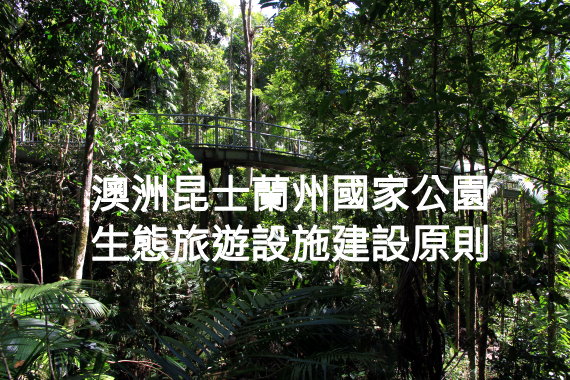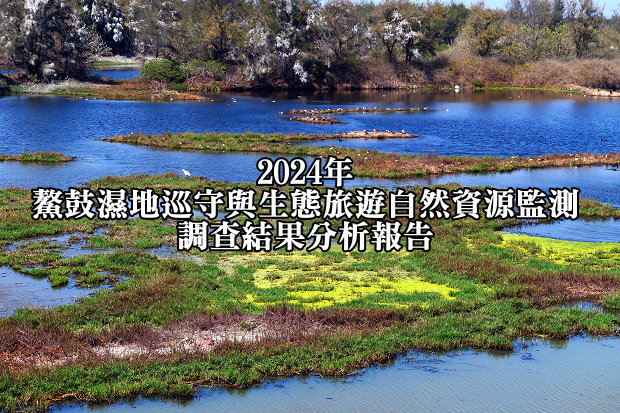
澳洲昆士蘭州國家公園生態旅遊設施建設原則
Queensland Ecotourism Investment Opportunities
Implementation Framework
Ecotourism Facilities on National Parks
原文下載處:https://www.npsr.qld.gov.au/tourism/pdf/ecofacilities-framework.pdf(2015/07公布)
翻譯:王梵、賴鵬智
背景
昆士蘭州國家公園暨體育與競賽廳已發展出一系列的政策以及立法措施,以求改善生態旅遊活動及遊客利用昆士蘭保護區系統的機會。
1992年訂定的自然保育法提供了私營的、低度衝擊的、有規劃的生態旅遊基礎建設在國家公園發展的機會。自然保育法確保了所有經過核准的生態旅遊設施都符合公眾利益、環境永續,並竭盡最大可能去保育土地的自然狀態以及保護其文化資源和自然價值。每個經過核准的設施,都會很謹慎地設計及管理,以確保與園區的自然和特色相符相容,並配合國家公園的管理。
生態旅遊設施的性質和規模,可能不同於相對小型的、結構簡單的遊獵營地或健行小屋,也不同於較大型的露營地或低度衝擊的生態旅館。認知到不同計畫間在規模和區位的歧異性,本廳將會制訂符合法規的共同評估標準和審核程序。
吸引投資生態旅遊設施的過程也有所不同,政府可能透過競標啟動機會,或投資者直接提計畫申請。
Background
The Queensland Department of National Parks, Sport and Racing (the department) has developed a range of policy and legislative measures to improve opportunities for sustainable ecotourism activities and visitor use in Queensland’s protected area system.
The Nature Conservation Act 1992 (NC Act) provides for development of privately-owned, low impact, purpose built ecotourism infrastructure on national parks. The NC Act provisions ensure that all approved ecotourism facilities are in the public interest, environmentally sustainable and, to the greatest possible extent, preserve the land’s natural condition and protect its cultural resources and natural values. Each approved facility will be designed and managed sensitively to ensure it is compatible with the nature and character of the site and complements the management of the national park in which it is located.
The nature and scale of ecotourism facilities may vary from relatively small, simple structures— such as safari tents or walker’s huts—to larger campgrounds or low impact eco-lodges. Acknowledging the differences of scale and location between proposals, the department will apply a common assessment and approval process consistent with the legislative requirements.
The process for attracting investment in ecotourism facilities will also vary—the government may initiate opportunities through competitive tendering; and investors with independent proposals can make direct approaches.
指導原則
國家公園生態旅遊設施的七個指導原則:
Guiding principles
Seven overarching principles guide the consideration of ecotourism facilities in national parks. They are:
原則1
國家公園生態旅遊設施不論是座落、設計以及謹慎地管理,都在確保符合國家公園的自然與文化價值。
國家公園展現了昆士蘭地景與生物多樣性的最高保育層次,因此,國家公園的生態旅遊設施必須符合生態永續性、審批合格、座落正確以及精心設計的,以保護公園的自然和文化價值。
生態旅遊設施只有在以下狀況才會被考慮核准:擬建案位置是依託在該場域的自然和文化價值上,也就是說,這個擬建案完全是為了國家公園的特色而規劃。
如果可能,應優先考慮利用國家公園已經擾動過的地區,而非開發一塊完整原始的自然區域(未開發區)。我們鼓勵將一些過剩的或未充分運用的建築適當的再利用(例如農場、工人宿舍和燈塔),在不同面向上提供難忘的、獨特的國家公園體驗。
Principle 1
Ecotourism facilities on national parks are located, designed and managed sensitively to ensure compatibility with the natural and cultural values of the national park
National parks represent the highest level of conservation protection of Queensland’s landscapes and biodiversity. Therefore, ecotourism facilities in national parks must be ecologically sustainable, accredited and be located and designed to protect the natural and cultural values of the park.
Ecotourism facilities will only be considered if the proposal is reliant on the natural and cultural values of the site in which they are proposed to be located. That is, the proposal is all about the special features of the national park.
Where available preference should be given to previously disturbed sites within national parks rather than intact natural areas (greenfield sites). We encourage the adaptive re-use of redundant or underutilized departmental buildings (such as old homesteads, workers quarters and lighthouses) to provide memorable, unique national park experiences with a point of difference.
原則2
國家公園的生態旅遊設施應該提供獨特的或創新的旅遊體驗
國家公園新的生態旅遊設施應展現最好的運營系統及服務,並提供獨特或創新的體驗以加值此場域內既有的旅遊機會。另一方面,新的建設可以提供必要的基礎設施支持現有的生態旅遊活動或加強其體驗與運作。
Principle 2
Ecotourism facilities on national parks should offer unique or innovative visitor experiences
New ecotourism facilities on national parks will demonstrate best practice systems and services, and offer unique or innovative experiences that add to the existing tourism opportunities available in the region.
Alternatively, new facilities could provide infrastructure necessary to support an existing ecotourism activity or enhance the experience or operation of an existing ecotourism activity.
原則3
促進多樣化的體驗和設施
國家公園多樣化的景觀和設施提供了廣泛的旅遊體驗。生態旅遊設施的類型不斷發展,相關活動的內容必須更加注意和相容國家公園目前或是未來的設施以及遊客體驗。
當一個公園已經有高使用率的遊憩設施時,應鼓勵業者提供新穎的、創新的遊憩設施,以補充現有設施。
Principle 3
Diverse experiences and settings are promoted
The diverse landscapes and settings in national parks offer a wide range of visitor experiences. The type of ecotourism facilities developed and the scope of the associated activities should be sensitive to and compatible with the current or desired future settings and visitor experiences in the national park.
Where a park contains high-use visitor facilities, ecotourism facilities are encouraged that offer new, innovative visitor infrastructure experiences that complement the existing facilities.
原則4
設施須提供公共利益
國家公園內的私人生態旅遊設施應該明確呈現最佳的公共利益。國家公園外的地方照說無法能有一樣的遊憩體驗。
生態旅遊設施應提供環境、社會與經濟上最大的公共利益。
Principle 4
Facilities will provide for the public interest
Privately owned ecotourism facilities on national parks should be clearly determined as the best use of the proposed site in relation to public interest.
Alternative sites offering an equivalent experience should not be reasonably available outside of the national park.
The ecotourism facilities should provide the greatest net public benefit considering the environmental, social and economic outcomes of the use.
原則5
成功的生態旅遊應該是由承諾最佳運用環境的業者來營運
生態旅遊可以展現對環境資源的最佳利用。業者藉由實踐經濟、環境與社會的「三重底線」來展現環境資源的商業可行性與企業運作的正當性。
作為生態旅遊規劃的主要元素,生態旅遊操作應該對國家公園以及當地社區的保育和管理有公平合理的貢獻。
Principle 5
Successful ecotourism operations are characterized by commercial operators who have commitment to environmental best practice
Environmental best practice is demonstrated through other ecotourism initiatives. Operators demonstrate sound commercial viability and sound business practice that is based on a triple bottom line approach.
As a primary element of the ecotourism proposal, ecotourism operations should make a fair and reasonable contribution back to the conservation and management of the national park and also to the local community.
原則6
在保護提案者智慧財產權的同時,生態旅遊設施的審批機制應該是一致且透明的。
生態旅遊設施計畫的評估與審議將公平、公開、公正的考慮所有指導原則。
評估等級將視擬建設施的自然性質、規模和地點而定。審批過程不損害申請者的智慧財產權。
Principle 6
The authorisation of ecotourism facilities will be consistent and transparent while protecting the intellectual property of the proponent
The process of assessing and authorising proposals for ecotourism facilities will consider all principles and be fair, open and impartial.
The level of assessment will be appropriate to the nature, scale and location of the proposed facility. The approval process will not compromise the intellectual property of the proponent.
原則7
設施的類型和期限將以投資水準和投資報酬率來核定
租賃、協議、執照、許可或授權,都有可能核准生態旅遊設施。核准的類型和期限,將以設施性質,資本額多寡,投資報酬率以及州政府的財政績效等為考量重點。
Principle 7
The type and duration of authorities granted will recognize the level of investment and rate of return on investment
A lease, agreement, licence, permit or authority may be granted to authorise ecotourism facilities. The type and duration of authority granted will consider the nature of the facility, level of capital investment, rate of return on investment and the financial return to the state.
生態旅遊設施定義
生態旅遊含括永續旅遊及自然體驗活動的廣泛內容,能增進遊客對自然、文化遺產的欣賞與理解,並以永續生態的方式經營管理。生態旅遊設施應聚焦在呈現與欣賞該地的自然與文化價值,而不可為了迎合違反這樣目的的活動而改變自然環境。
昆士蘭州政府已經決定溜索這項活動並不適合設在國家公園。
怎樣才能稱為「生態旅遊設施」?本廳考慮如下:
★ 該設施如何以及到什麼程度可以呈現、欣賞與保存該地的自然狀況、文化資源與價值(這是主要目的)—該設施應對國家公園資產做出公平合理的貢獻。
★無論設施或活動都應呈現、欣賞與保存土地的自然狀況與文化資源及其價值。
★活動若與上述考量衝突,將會對土地的自然狀況產生嚴重衝擊,或是對文化資源與價值產生不利影響。每項生態旅遊設施建設計畫的評估都是個案處理,只認定是否符合定義。
Definition of ‘ecotourism facility’
Ecotourism encompasses a broad spectrum of responsible, nature-based activities that increase visitor appreciation and understanding of natural and cultural heritage, and are managed to be ecologically sustainable. Ecotourism facilities should focus on presenting and appreciating an area’s natural and cultural values, and not involve modification of the natural environment for activities contrary to this purpose.
The Queensland Government has determined that ecotourism opportunities incorporating ziplines are not considered as appropriate for national parks.
In deciding whether a proposed ecotourism facility meets the definition, the department will consider:
• how, and to what degree, the facility will contribute to presenting, appreciating and conserving the land’s natural condition and cultural resources and values (the primary purpose)—the facility should make a fair and reasonable contribution to the national park estate, including the park in which the facility is located
• whether or not the facility involves activities that are consistent with presenting, appreciating and conserving the land’s natural condition and cultural resources and values; and
• if some of the activities are inconsistent, whether or not they would have significant impacts on the land’s natural condition or adversely affect the land’s cultural resources and values. Each proposal for an ecotourism facility will be assessed on a case-by-case basis to ensure the requirements of the definition are met.
公眾利益
Public interest
有關公眾利益的考量因素:
In determining public interest the factors considered include:
‧環境效益
1. 生態永續性以及對自然和文化價值的衝擊(參見「生態永續利用」)
2. 環境管理計畫
3. 夥伴關係或對國家公園的管理作為或保育計畫有所貢獻
• environmental outcomes:
1.ecological sustainability and the impact on natural and cultural values (see section Ecologically sustainable use)
2.environmental management plans
3. partnerships or contributions to national park management activities or conservation programs.
‧社會效益
1. 增進社區使用國家公園公共設施、地標景點、水道、海灘、沿岸的可及性,或經過國家公園進入以上的設施場域。
2. 使用國家公園現有的遊憩和商業服務,未來亦有使用其他遊憩和商業服務的機會。
3. 設施該如何以及在多大的程度內限制或禁止公眾的使用。本廳將確保只在有必要實施管制的區域限制公眾進入(也就是園區絕大部分是開放給公眾使用的)。
4. 規劃地點須符合社會成效的目的
5. 透過公眾諮詢獲取建議
• social outcomes:
1.enhancements of community access to existing public facilities, iconic places, waterways, beaches and foreshores within the national park or accessed through the national park
2.interactions with existing recreational and commercial uses of the national park and future opportunities for other recreational and commercial uses
3.how, and to what degree, the facility will limit or restrict public access. The department will ensure that exclusive use areas are restricted to only those areas that are necessary to operational requirements (that is, large sections of park are not to be excluded from public access)
4.general suitability of the proposed location for the purpose
5.advice received through public consultation
‧經濟效益
1. 提案者有建設及長期維運設施的財務與管理能力
2. 創造當地就業機會以及支持現有工作機會
3. 對當地社區以及原有經營者的經濟效益
4. 對當地企業帶來直接效益,包括對既有的旅遊業者。
5. 對政府產生直接和間接的成本與效益
6. 政府在公有土地上的商業服務產生財政績效
• economic outcomes:
1.the financial and managerial capability of the proponent to establish the facility, and sustain its long term viability
2.local job creation and support for existing jobs
3.economic benefits to the local community and traditional owners
4.flow-on benefits to local businesses, including existing tourism businesses
5.direct and indirect costs and benefits to the government
6.financial return to the government for commercial use of public land.
生態永續利用
「生態永續利用」是指在某一區域以維持自然過程的方式使用環境資源,並確保在這自然過程中,不會減少未來獲利的潛力。
用永續手法在土地上建置具有高度生態與文化價值的設施,例如在國家公園體系,相關的架構與活動必須充分整合,並與生態系統、環境特色及限制加以協調相容。
以下幾項永續原則將被用來認定生態旅遊設施是否符合要求:
1. 保護生態系統、自然景觀和特殊物種。
2. 儘量減少棲地喪失,避免外來入侵的野草、有害動植物等。
3. 場域設計、布局和建築材料須融入自然景觀特色,對環境影響降到最低並與景觀相容。
4. 有效和永續使用水和能源
5. 廢棄物最少化和回收策略
6. 儘量減少噪音與光害並注意空氣品質。
Ecologically sustainable use
The term ‘ecologically sustainable use’ refers to allowing the use of an area in a way that sustains natural processes and ensures that potential for future benefits from these natural processes are not diminished.
A sustainable approach to establishing facilities on land with high ecological and cultural values, such as national parks, requires structures and associated activities to be fully integrated and in harmony with the ecosystem and its environmental features and constraints.
When determining whether a proposed ecotourism facility is ecologically sustainable the following sustainability principles will be considered:
• preserving ecosystems, natural landscapes and special species
• minimising habitat loss and weed and pest invasions
• site designs, layouts and construction materials that incorporate natural landscape features, minimize environmental impacts and suit the landscape
• efficient and sustainable use of water and energy
• waste minimisation and recycling strategies
• minimising impacts from noise and lighting sources, and on air quality.
對環境和文化衝擊降至最低
生態旅遊設施必須儘可能保護土地的自然狀態與其文化資源和價值。
政府會以底下幾項原則考慮擬建的生態旅遊設施是否保存和保護自然與文化資源及價值:
1. 土地的自然狀態以及既存的干擾程度
2. 土地保育的重要性以及其自然和景觀的構成要件
3. 土地的文化資源和價值,包括自然、歷史和原住民場域。
4. 擬建設施使用的範圍和等級是否會影響上述狀況,以及是否有設施極小化與適切管理的對策,或是採取怎樣的補償措施。
Minimising environmental and cultural impacts
Ecotourism facilities must, to the greatest possible extent, preserve the land’s natural condition and protect its cultural resources and values.
When determining whether a proposed ecotourism facility preserves and protects natural and cultural resources and values, the government will consider the:
• natural condition of the land and extent of any existing disturbance to the natural condition
• conservation significance of the land and its natural and landscape components
• cultural resources and values of the land, including natural, historic and indigenous places
• extent and degree that the proposed use will impact on the above, and whether strategies that minimise, adequately manage, or offset these impacts can be implemented.
延伸閱讀:
本網誌「旅遊地經營管理」、「生態旅遊或觀光遊憩」、「澳洲系列」、「環境保護」、「生態保育」與「環保旅館」等專欄各文







希望新北市的觀旅局可以好好的學習